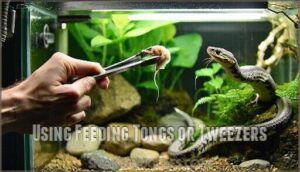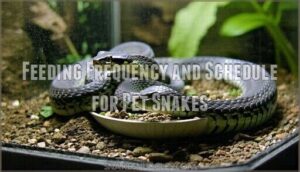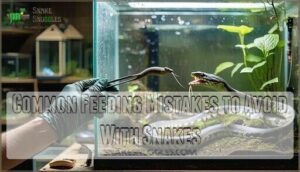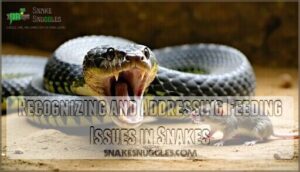This site is supported by our readers. We may earn a commission, at no cost to you, if you purchase through links.
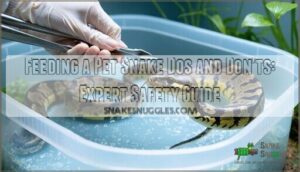 Mastering feeding a pet snake dos and don’ts keeps both you and your scaly companion safe.
Mastering feeding a pet snake dos and don’ts keeps both you and your scaly companion safe.
Do offer appropriately sized prey—no bigger than your snake’s widest body section. Don’t feed live prey; it’s risky business that can injure your pet.
Do use feeding tongs to maintain safe distance and prevent mistaken identity bites. Don’t handle your snake for 24-48 hours post-meal—digestion requires peace and quiet.
Do feed in a separate container to avoid substrate ingestion. Don’t overfeed; snakes aren’t eating machines like your neighbor’s golden retriever.
Pre-killed frozen prey offers convenience and safety. The devil’s in the details when establishing proper feeding routines.
Table Of Contents
- Key Takeaways
- Choosing The Right Prey for Your Snake
- Proper Preparation of Snake Food
- Safe Feeding Techniques for Pet Snakes
- Feeding Frequency and Schedule for Pet Snakes
- Live Vs. Pre-killed Prey: Pros and Cons
- Common Feeding Mistakes to Avoid With Snakes
- Recognizing and Addressing Feeding Issues in Snakes
- Supplementing Your Snake’s Diet: When and How
- Frequently Asked Questions (FAQs)
- What not to do when feeding a snake?
- What is the best way to feed a pet snake?
- How long not to touch a snake after feeding?
- How to know if a pet snake is hungry?
- How often should I feed my pet snake?
- How long should I not touch my snake after feeding?
- How to tell if your snake is hungry?
- Can snakes eat human food?
- How long can snakes go without eating?
- Should I feed my snake in its enclosure?
- Conclusion
Key Takeaways
- Feed pre-killed frozen prey only – Do not use live prey that can bite and seriously injure your snake, and never microwave frozen rodents as this creates dangerous hot spots.
- Choose appropriate prey size – Do not offer food larger than your snake’s thickest body section, as oversized meals cause regurgitation and potential choking.
- Wait 24-48 hours before handling – Do not touch your snake after feeding as this disrupts digestion and can cause dangerous regurgitation.
- Use feeding tongs and separate containers – Do not feed by hand or in the main enclosure to prevent bites and substrate ingestion while maintaining proper hygiene.
Choosing The Right Prey for Your Snake
Selecting appropriate prey for your snake isn’t just about grabbing the first frozen mouse from the pet store—it’s a critical decision that directly impacts your pet’s health and wellbeing.
You’ll need to evaluate your snake’s species, size, age, and nutritional requirements so that they receive a balanced diet that supports proper growth and development.
Understanding Snake Dietary Needs
All snake species are obligate carnivores requiring exclusively animal-based dietary needs.
Understanding snake nutrition fundamentals guarantees proper snake health—your pet needs whole prey providing complete protein, fat, and mineral balance.
Snake dietary needs vary by species, age, and size, but food quality remains paramount.
Smart feeding habits support natural digestion patterns, while proper reptile nutrition facts guide portion control and meal frequency for ideal wellness.
Providing the right snake nutrition guidelines is vital for maintaining a healthy pet snake.
Types of Prey Suitable for Different Snake Species
Your pet’s dietary needs depend on their species and natural hunting patterns.
Most common pet snakes thrive on Rodent Prey like mice and rats, which provide complete nutrition.
Here’s what works for popular species:
- Corn snakes and ball pythons – Mice and rats form their primary snake diet plan
- Garter snakes – Fish and Amphibian Diet options like frogs work best
- King snakes – Reptile Food including other snakes plus rodents
Bird Prey suits some species, while Insect Bait works for smaller snakes.
Match your pet snake care approach to their natural preferences.
Importance of Prey Size Relative to Snake Size
Getting prey size right isn’t rocket science, but it’s the difference between a healthy snake and a trip to the vet.
Right prey size prevents vet visits and keeps your snake thriving.
Your snake’s mouth can stretch, but that doesn’t mean it should. Choose prey no larger than your snake’s widest body section—roughly 1 to 1.5 times the diameter.
Too big causes regurgitation; too small leaves them hungry.
Proper prey selection supports healthy snake growth while preventing feeding complications that stress both you and your pet.
Nutritional Value of Different Prey Options
Different prey types offer distinct nutritional profiles that directly impact your snake’s health. Prey Variety guarantees thorough Nutrient Balance, while Feed Quality determines vitamin absorption.
Understanding Dietary Needs helps you select the best Protein Sources for long-term wellness.
Here are key nutritional value considerations for prey options:
- Mice and rats – Complete protein with balanced amino acids and essential fats
- Chicks and quail – Higher vitamin A content, supporting skin and eye health
- Rabbit – Lean protein ideal for larger species, lower fat content
- Fish – Rich in omega-3s but requires vitamin supplementation for deficiencies
- Gut-loaded prey – Enhanced calcium, vitamins, and minerals through specialized feeding
Smart snake nutrition tips focus on rotating protein sources to prevent deficiencies. Reptile nutrition research shows whole prey provides balanced minerals naturally.
Your snake diet benefits most from species-appropriate variety rather than single-source feeding.
Proper Preparation of Snake Food
Preparation makes all the difference between a healthy snake and potential problems.
Prey thawing requires patience—use cold water or refrigerator methods, never microwaves that create dangerous hot spots.
Proper food storage keeps frozen prey fresh for months.
Meal planning helps establish consistent routines your snake expects.
Prey handling with clean hands prevents contamination.
Consider snake nutrition needs when selecting snake food options—gut-loaded rodents offer enhanced vitamins.
Match prey size to your snake’s measurements.
These snake feeding tips guarantee safe, nutritious meals every time.
Safe Feeding Techniques for Pet Snakes
Feeding your snake properly isn’t just about dropping food into the enclosure—it’s about creating a safe, stress-free experience for both you and your pet.
These proven techniques will help you master the art of snake feeding while avoiding common mishaps that can lead to bites, regurgitation, or behavioral issues.
Using Feeding Tongs or Tweezers
Feeding tongs become your best friend when presenting prekilled prey to your snake.
Choose 12-15 inch metal feeding tongs for ideal snake safety and prey presentation.
Grip the rodent by its scruff, then wiggle it gently to mimic natural movement—this feeding technique triggers your snake’s hunting instincts.
Never jerk the prey away during strikes, as this creates unnecessary stress during your feeding routine.
Proper handling with feeding tongs tools is essential for a safe and successful feeding experience.
Offering Prey in a Designated Feeding Area
Beyond just keeping things tidy, establishing dedicated feeding areas creates a controlled environment that reduces stress and prevents substrate ingestion.
Your snake will associate this space with mealtime, making feeding routines more predictable and safer.
Consider these practical feeding areas:
- Feeding trays placed inside snake enclosures for easy cleanup
- Separate containers that prevent cage association with food presentation
- Designated spots using feeding tongs to maintain consistent hygiene practices
Monitoring The Feeding Process
Watching your snake’s feeding response reveals vital insights about their health and well-being.
Close observation prevents injuries from live prey and guarantees complete food intake.
Monitor for proper swallowing technique and normal eating habits throughout the snake feeding process.
Ensuring your snake’s longevity requires consistent health monitoring.
| Normal Feeding Cues | Warning Signs |
|---|---|
| Alert tongue-flicking and focused attention | Excessive defensiveness or striking |
| Steady prey consumption without hesitation | Repeated regurgitation attempts |
| Calm post-feeding behavior | Respiratory distress or choking |
Use feeding tongs while observing snake behavior during meals.
Track feeding dates and responses to identify patterns in your pet’s eating habits.
Handling Snakes During and After Feeding
Your snake’s stomach is like a busy construction zone after feeding—no disturbance allowed!
Wait 24-48 hours before handling to prevent regurgitation risk.
Handling stress increases bite risk and disrupts digestion time.
During postfeeding behavior, snakes need quiet recovery.
Avoid common feeding mistakes by respecting this safe interaction window.
Patience prevents messy regurgitation disasters!
Feeding Frequency and Schedule for Pet Snakes
Getting your snake’s feeding schedule right isn’t just about preventing hangry serpent syndrome—it’s essential for their health and longevity.
The frequency depends on your snake’s age, species, and individual metabolism, with younger snakes requiring more frequent meals than their adult counterparts, which is crucial for their overall longevity.
Age-based Feeding Guidelines
Your snake’s appetite changes like clockwork as they age.
Hatchling feeding requires meals every 5-7 days to fuel rapid growth, while juvenile snakes can wait 7-10 days between portions.
Adult snakes need feeding every 10-14 days, with senior diets potentially extending to three weeks.
This snake feeding schedule isn’t arbitrary—younger reptiles burn energy faster than their mature counterparts, requiring more frequent meals to thrive.
Species-specific Feeding Requirements
Your ball python’s dietary needs differ drastically from a corn snake’s appetite—it’s like comparing a marathon runner to a couch potato!
Ball python feeding requires meals every 2-4 weeks, while corn snakes need weekly feedings.
Check feeding charts for your specific snake species since prey variety and feeding frequency vary substantially.
Understanding these species diets prevents overfeeding disasters.
Adjusting Feeding Schedules for Breeding Seasons
When breeding seasons roll around, your snake’s nutritional needs shift dramatically.
Reproductive females require strategic dietary adjustments to support egg development and maintain proper body condition throughout this demanding period.
- Increase feeding frequency – Feed gravid females every 7-10 days instead of standard 10-14 day intervals
- Boost prey size – Offer slightly larger rodents (within safe parameters) for enhanced breeding nutrition
- Monitor weight changes – Track body condition to guarantee proper reproductive health maintenance
- Maintain dietary flexibility – Adjust feeding cycles based on individual appetite and breeding progression
Signs of Overfeeding or Underfeeding
Regularly monitoring your snake’s physical condition prevents serious feeding issues from developing unnoticed. Weight changes are the most reliable indicator—rapid gains suggest snake obesity, while gradual loss indicates malnutrition signs requiring immediate attention.
| Overfeeding Signs | Normal Condition | Underfeeding Signs |
|---|---|---|
| Rounded body shape, difficulty moving | Muscular build, active behavior | Visible ribs, lethargy |
| Frequent regurgitation episodes | Regular successful digestion | Appetite loss, extended shed cycles |
| Fatty deposits around neck/tail | Consistent weight maintenance | Dull skin, dehydration symptoms |
Health monitoring involves tracking feeding frequency, appetite patterns, and post-meal behavior. Overfeeding creates digestive stress and reduces lifespan, while underfeeding compromises immune function and growth rates in developing snakes.
Live Vs. Pre-killed Prey: Pros and Cons
One of the most important decisions you’ll make as a snake owner is choosing between live and pre-killed prey for your pet.
This choice directly impacts your snake’s safety, your convenience, and the overall feeding experience you’ll both have together, which is a complete concept that encompasses several key aspects.
Risks Associated With Live Prey Feeding
Beyond appearance, live prey feeding creates serious hazards for your snake’s health and safety.
Live rodents can inflict devastating bite wounds, causing eye damage, spinal injuries, or fatal infections. Even large pythons have required euthanasia after rodent attacks.
Even large pythons have died from rodent attacks—live feeding isn’t worth the risk.
| Risk Category | Specific Dangers |
|---|---|
| Snake Injury | Deep puncture wounds, eye damage, spinal trauma |
| Prey Attacks | Defensive biting, scratching, prolonged assault |
| Disease Transmission | Bacterial infections, parasites, viral pathogens |
| Feeding Stress | Psychological trauma, feeding refusal, behavioral issues |
| Management Risks | Constant supervision required, emergency veterinary costs |
Live feeding demands continuous monitoring—unattended prey may attack during shedding or illness when snakes can’t defend themselves.
Benefits of Using Pre-killed or Frozen-thawed Prey
Why choose pre-killed over live prey? The answer’s simple—safety meets convenience.
Frozen-thawed rodents eliminate bite risks while providing consistent nutrition. You’ll control feeding schedules easily, and your snake enjoys stress-free meals without injury concerns.
For a reliable source of pre-killed prey, consider suppliers that offer pre killed mice for a convenient feeding solution.
| Aspect | Live Prey | Frozen-Thawed |
|---|---|---|
| Safety | Bite/scratch risk | Zero injury risk |
| Storage | Requires live care | Freezer convenience |
| Nutrition | Variable quality | Consistent nutrients |
Transitioning Snakes From Live to Pre-killed Prey
Converting snakes from live prey to prekilled benefits requires patience and smart tactics.
Your snake’s prey preference might resist change, but these feeding switch methods work:
| Method | Timeline | Success Rate |
|---|---|---|
| Fresh-killed warming | 1-2 weeks | High |
| Movement simulation | 2-4 weeks | Medium |
| Scent enhancement | 3-6 weeks | Variable |
| Gradual acclimation | 4-8 weeks | Highest |
Start with fresh-killed prey warmed to body temperature.
Wiggle it using feeding tongs to trigger strike response.
Be patient – snake nutrition shouldn’t be rushed during prey conversion phases.
Proper Thawing and Preparation of Frozen Prey
Proper thawing transforms frozen prey into safe, appealing meals for your snake. Never microwave frozen feeders—heat creates dangerous bacterial hot spots that’ll make your pet sick.
| Thawing Methods | Safe Thawing Process |
|---|---|
| Cold Water Bath | Seal prey in plastic bag, submerge 2-4 hours |
| Refrigerator Thaw | Place on plate, thaw overnight (8-12 hours) |
| Room Temperature | Leave sealed for 4-6 hours maximum |
| Warm Water Finish | Brief lukewarm rinse before serving |
| Temperature Check | Verify prey feels room temperature throughout |
Check that thawed prey feels uniformly soft—no frozen centers remain. Proper prey preparation prevents regurgitation and guarantees your snake’s digestive success. Following proper thawing guidelines is vital for maintaining the quality and safety of the frozen snake food.
Common Feeding Mistakes to Avoid With Snakes
Even experienced snake keepers make feeding mistakes that can harm their pets or create behavioral problems.
Learning what not to do is just as important as mastering proper techniques—your snake’s health depends on avoiding these common pitfalls, which is crucial for maintaining their well-being and preventing issues, making behavioral problems a key concern.
Offering Inappropriate Prey Size or Type
When feeding your snake, prey size errors rank among the most dangerous feeding mistakes.
Offering oversized prey can cause regurgitation, choking, or internal injury—imagine your snake struggling like someone who bit off more than they could chew!
Proper prey selection means choosing food no larger than your snake’s thickest body section.
This simple rule prevents serious snake nutrition complications and keeps feeding safe.
Handling Snakes Immediately After Feeding
After your snake finishes its meal, hands off for at least 24-48 hours! Post feeding care requires patience—handling too soon triggers regurgitation and snake stress. Your pet needs time to digest properly.
Here’s your snake safety checklist for handling tips:
- Wait period: No contact for 24-48 hours minimum after feeding
- Watch for bulge: Visible food lump means digestive process isn’t complete
- Monitor behavior: Defensive posturing signals your snake needs more recovery time
Following proper snake feeding precautions protects your pet’s health and maintains a consistent feeding schedule.
Feeding in The Snake’s Main Enclosure
Many snake owners make the mistake of dropping prey directly into their pet’s main habitat.
While convenient, this approach creates several problems with your snake feeding environment and cage hygiene.
Your snake may develop food aggression, mistaking your hand for dinner during routine maintenance.
Using feeding tongs in a separate container prevents this confusion and maintains better environmental control through proper enclosure setup.
Proper snake care involves understanding common snake feeding mistakes to avoid, including recognizing signs of overfeeding and the importance of prey quality guidelines.
This approach is crucial for maintaining a healthy and safe environment for your pet snake, emphasizing the need for proper enclosure setup.
Neglecting Proper Hygiene During Feeding
During snake feeding sessions, Cross Contamination becomes your worst enemy. Dirty Enclosures and contaminated Feeding Utensils threaten Snake Health through bacterial transmission.
Essential Hygiene Practices include:
- Sterilize feeding tongs between uses
- Clean snake feeding environment regularly
- Wash hands before/after handling
- Remove uneaten prey immediately
These snake feeding dos and donts guarantee snake feeding safety while maintaining proper snake feeding hygiene standards.
Recognizing and Addressing Feeding Issues in Snakes
Even the most docile snake can develop feeding problems that’ll leave you scratching your head and reaching for your phone to call the vet.
You’ll need to spot these issues early and know exactly when professional intervention becomes necessary to keep your scaly friend healthy and thriving.
Signs of Appetite Loss or Refusal to Eat
Recognizing appetite loss isn’t rocket science, but missing these hunger cues can spell trouble.
Watch for persistent refusal signs like avoiding prey, hiding excessively, or showing lethargy.
Snake anorexia often stems from feeding stress, environmental issues, or approaching shed cycles.
Distinguishing between normal fasting and concerning refusal to eat helps prevent serious health complications in your serpent companion.
Identifying key sick snake signs is essential for providing proper care and addressing potential health issues promptly.
Dealing With Picky Eaters
Some picky eaters make snake feeding techniques feel like negotiating with a stubborn toddler.
When your snake shows eating habits bordering on fussy, try these refusal tactics solutions:
- Vary prey size – smaller rodents might appeal to hesitant feeders
- Change scenting methods – rub prey with chicken broth or fish
- Adjust environmental conditions – guarantee proper temperature and hiding spots
Snake appetite issues often resolve with patience and consistent feeding pet snakes schedules.
Addressing Regurgitation Problems
When your snake brings back dinner, you’re facing more than picky eating.
Regurgitation causes range from stress and incorrect temperatures to oversized prey.
Snake stress from excessive handling often triggers immediate food rejection.
Temperature fluctuations disrupt digestion, causing delayed regurgitation.
Feeding errors like offering prey too large create digestive issues.
Monitor for signs: undigested meals appearing hours or days later.
Address snake feeding mistakes by reducing handling, checking heat gradients, and downsizing prey.
Overfeeding compounds problems, while underfeeding weakens digestive capacity.
Quick action prevents recurring regurgitation episodes, ensuring a healthy digestive system and preventing future regurgitation issues.
When to Seek Veterinary Assistance for Feeding Issues
Three specific situations demand veterinary assistance for snake feeding issues: persistent regurgitation beyond 48 hours, complete feeding refusal lasting over two weeks, or visible signs of mouthrot disease.
Don’t play guessing games with snake health—feeding emergencies and snake malnutrition require professional health checks to prevent serious complications.
Supplementing Your Snake’s Diet: When and How
While whole prey typically provides complete nutrition for most snakes, certain circumstances require targeted supplementation to maintain peak health.
You’ll need to think about vitamin and mineral additions for breeding females, growing juveniles, or snakes with specific dietary restrictions that standard rodent meals can’t fully address.
Vitamin and Mineral Supplementation Guidelines
Most snakes don’t need supplements when fed whole prey, but certain situations call for extra nutritional support.
Understanding proper supplementation prevents deficiencies while avoiding dangerous toxicity.
Consider supplementation for these scenarios:
- Young snakes – Light calcium dusting every other feeding supports rapid growth
- Indoor reptiles – Vitamin D supplementation compensates for lack of natural sunlight
- Breeding females – Multivitamins during reproductive periods maintain mineral balance
Whole prey provides ideal calcium needs and nutritional value naturally.
Over-supplementation with vitamin A or vitamin D risks organ damage, so veterinary guidance guarantees supplement safety for proper snake nutrition.
Proper snake care involves understanding snake health supplements to make informed decisions about their diet and well-being.
Offering Variety in Prey Options
Beyond the same-old frozen mouse routine, prey rotation keeps your snake’s diet interesting and nutritionally complete.
Rotate between different rodent types—mice, rats, gerbils—to maximize nutrient balance and prevent deficiencies.
Some species appreciate dietary variety like quail or fish.
This dietary enrichment mimics natural hunting patterns while ensuring your snake gets diverse vitamins and minerals from varied prey options.
Gut-loading Prey for Enhanced Nutrition
Gut-loading transforms ordinary prey into nutritional powerhouses for your snake. This process involves feeding nutrient-rich foods to rodents before offering them to your pet, substantially boosting their dietary value.
To optimize gut-loading, understanding proper gut loading food techniques is essential for snake owners.
Key gut-loading benefits include:
- Enhanced vitamin absorption – Prey loaded with leafy greens delivers essential vitamins A and D
- Mineral fortification – Calcium-rich foods strengthen prey’s nutritional profile for better snake health
- Improved digestibility – Well-fed prey provides superior nutritional density compared to standard options
Special Dietary Considerations for Pregnant Snakes
Expecting snake mothers require enhanced Pregnancy Nutrition to support developing eggs.
Increase feeding frequency and provide calcium plus vitamin supplementation for ideal Reproductive Health.
Monitor your gravid female’s appetite closely—she’ll likely eat more frequently than usual.
| Nutritional Aspect | Gravid Female Requirements |
|---|---|
| Feeding Frequency | Increase by 25-50% over normal schedule |
| Calcium Supplementation | Essential for shell development |
| Vitamin D3 | Critical for calcium absorption |
Frequently Asked Questions (FAQs)
What not to do when feeding a snake?
Don’t ever use live prey that could injure your snake, avoid oversized meals larger than their thickest body part, skip handling for 24-48 hours post-feeding, and never microwave frozen rodents.
What is the best way to feed a pet snake?
Use feeding tongs to offer pre-killed, appropriately-sized frozen-thawed rodents in a calm environment. Feed juveniles weekly, adults bi-weekly. Avoid live prey—it’s risky business that can seriously injure your snake.
How long not to touch a snake after feeding?
Though you might think your snake won’t mind a quick pet after dinner, wait 24-48 hours before handling.
This prevents regurgitation and reduces stress during the critical digestion period when your snake’s vulnerable.
How to know if a pet snake is hungry?
Your snake’s behavior tells the story—active hunting movements, tongue flicking, and exploring their enclosure signals hunger.
Check their feeding schedule; most adults eat every 10-14 days while juveniles need weekly meals.
How often should I feed my pet snake?
Don’t worry about overfeeding—it’s actually more common than you’d think! Feed young snakes every 5-7 days, adults every 10-14 days based on species requirements.
How long should I not touch my snake after feeding?
Wait 24-48 hours before handling your snake after feeding.
This allows proper digestion and prevents regurgitation, which can be dangerous.
Your snake needs this downtime to process its meal safely and comfortably.
How to tell if your snake is hungry?
Behavioral cues clearly communicate your serpent’s appetite status.
Watch for increased activity, tongue-flicking, and restless movement around feeding time.
You’ll notice hunting postures, alert positioning, and heightened responsiveness to movement.
Most snakes show predictable patterns when hungry.
Can snakes eat human food?
No, you shouldn’t feed your snake human food.
Snakes are obligate carnivores requiring whole prey like rodents.
Human food lacks essential nutrients and can cause serious digestive issues, malnutrition, or death in your pet.
How long can snakes go without eating?
Can time stand still?
Adult snakes can survive months without food, typically 2-6 months depending on species, size, and health.
Your snake’s metabolism slows dramatically during fasting periods, making this normal behavior, not cause for alarm, as it is a result of the snake’s ability to survive with a slowed metabolism.
Should I feed my snake in its enclosure?
You can feed your snake in its enclosure, but many keepers prefer using a separate container.
In-cage feeding is simpler, while separate feeding prevents the snake from associating its home with food, reducing defensive behavior.
Conclusion
Success demands precision—failure brings danger.
Mastering feeding a pet snake dos and don’ts guarantees your reptilian companion thrives while protecting you from preventable mishaps.
You’ve learned proper prey sizing, safe handling techniques, and feeding schedules that promote peak health.
Remember, frozen-thawed prey beats live options every time for safety.
Establish consistent routines, maintain sterile conditions, and trust your observations.
Your snake’s wellbeing depends on these evidence-based practices becoming second nature through careful implementation, ensuring peak health.
- https://www.webvets.com/blog/feeding-your-pet-snake-112.html
- https://www.aquariumindustries.com.au/wp-content/uploads/2015/03/A-Guide-to-Feeding-Reptiles.pdf
- https://www.petsmart.com/learning-center/reptile-care/how-to-feed-your-snake/A0166.html
- https://www.lllreptile.com/articles/130-feeding-stubborn-snakes/
- https://vettoday.com/blog/pet-health/how-often-do-snakes-eat/

